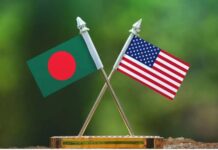 Robust exchange rate critical for sustained growth
Robust exchange rate critical for sustained growth

Poorly managed exchange rate, ad hoc-based incentive and existing domestic protection levels will not make Bangladesh’s exports competitive and help diversify both products and destinations, according to a new plan of the government.
“Poorly managed exchange rate can be disastrous for economic growth,” said the Perspective Plan of Bangladesh for 2021 to 2041.
The National Economic Council (NEC) at its meeting at Sher-e-Bangla Nagar in the city yesterday approved the plan. Prime Minister Sheikh Hasina, chairman of the NEC, presided over the meeting.
“For a long-term plan, an ambitious target is required first. Long-term and far-reaching political and economic steps are needed to advance the plan,” said Shamsul Alam, a member of the General Economics Division, while presenting the summary of the plan.
In the plan, export diversification and competitiveness in the global market have been identified as the major challenges facing Bangladesh.
The plan called for export diversification as over-reliance on a single export commodity makes the economy vulnerable to external shocks.
A diverse export basket is absolutely necessary for stable export revenue and its growth.
Garment accounts for more than 80 per cent of the national exports, while the EU, the US and Japan are the major export destinations.
According to the plan, researches showed that avoiding significant overvaluation of the currency is one of the most robust imperatives that can be gleaned from diverse experience with economic growth around the world and one that appears to be strongly supported by cross-country statistical evidence.
Overvalued currencies are associated with foreign currency shortages, rent-seeking and corruption, unsustainably large current account deficits, balance of payment crisis and stop-and-go macroeconomic cycles, all of which are damaging to economic growth.
As a long-term strategy for export expansion, the appropriate exchange rate management would be to avoid rigidity or real appreciation of the real effective exchange rate (REER).
A moderately depreciating REER would work better to sustain the competitiveness of exports, particularly non-garment exports.
About the trade policy stance, the plan said perhaps the single most important determinant of export competitiveness is the incentive regime emerging from trade policy.
International experience suggests that in a high tariff regime, export success cannot come through subsidies provided to thrust sectors.
It could, however, come through providing garment-like free trade channel to existing and potential exports.
“That is big policy change. While there is no magic recipe to promote diversification, a broad array of policies must be needed to create and sustain new export products.”
Bangladesh’s trade regime needs further rationalisation and modernisation of the tariff regime, it said.
To continue on a path of sustainable export growth with a diversified basket of goods, Bangladesh faces an immediate challenge to restructure its tariff regime in order to gradually phase out effective protection levels and anti-export bias, it said.
The plan suggested four steps to diversify exports.
Import regime must be made seamless to facilitate duty-free imported input into exports. The incentive structure for export must be set right by ensuring that relative incentives for export and import substitute production are about the same.
Lowering the cost of trade-related services like transport, logistics and energy infrastructure is important, it said.
Proactive policies, such as helping exporters upgrade existing products, break into geographic markets, and launch and consolidate new line of business abroad, might be important in respect of the limited capacity of the government.
The government has taken a positive fiscal stance to promote exports.
The garment sector is the highest beneficiary of the various fiscal concessions.
In addition to the duty drawback scheme accorded to all exporters, the garment exporters enjoy the special privilege of paying only a nominal income tax on their earnings.
In addition, the government offers direct cash subsidy for export of non-traditional items, with the rate varying from 5 per cent on jute yarn to 20 per cent on halal meat and potatoes in the current year.
“Fiscal incentive should not be ad hoc. The basis should be a potential competattive advantage determined by research evidence. For all the fiscal incentives for exports, they are no match to the high tariff protection received by import substitutes,” the plan said.
Port services, road rail network, rail system, air freight and airport storage services, ease of doing business and addressing low labour productivity and skill gap are crucial for export competitiveness, the plan said.
The plan targets to raise the contribution of the service sector to the economy to 62 per cent from existing 54 per cent during the period.
The government also wants to increase the share of the industrial sector to 40 per cent by 2031 before bringing it down to 33 per cent by 2041.
The contribution of agriculture will gradually come down to 5 per cent by the end of the plan period.
The per capita income of Bangladesh will reach $12,500 in 2041 from $1,909 now, said Planning Minister MA Mannan.









